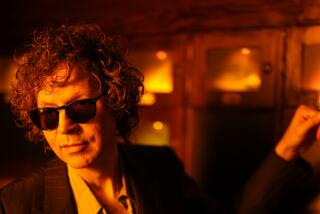A Tony Bennett revival? They’re singing his song
Reporting from New York — — By his own admission, Tony Bennett doesn’t get nervous often. But he was anxious that day, more than 50 years ago, when he was filling in for Perry Como as host on the crooner’s variety television show.
“Como had a big orchestra and great stars,” Bennett recalled. “And all they gave me was a blank stage. I thought, ‘There was no way I’m going to get through this.’”
Bennett decided there was pretty much only one person who could help: a certain blue-eyed singer. “I had never met Frank Sinatra. I didn’t even know he knew me,” Bennett said. “But they brought me to his dressing room at the Paramount Theater [where he was performing]. I asked him what I should do, and he told me one simple thing: ‘If you’re nervous, the audience will sense that. And they’ll help pull you through.’”
The audience has been pulling Bennett through for a long time, and he has returned the favor. In a 59-year recording career that has netted him 15 Grammys, Bennett has become famous for songs such as “I Left My Heart in San Francisco,” “Because of You” and “For Once in My Life,” among many others. He has released an eye-popping 74 albums, selling more than 50 million.
Bennett will look to add to that total with “Duets II,” another album of odd-couple standards that comes out Sept. 20. A follow-up to the 2006 hit “Duets,” the new collection features Bennett recording with a panoply of stars young and old, and it stands as a kind of implicit testament to his timeless, cross-genre appeal. Carrie Underwood is on the album; so are Aretha Franklin, Lady Gaga, Alejandro Sanz and Willie Nelson.
In a particularly poignant turn, Amy Winehouse accompanies him in the 1930 standard “Body and Soul” (“You try to not hear/ Turn a deaf ear/ To my prayer ... My heart is sad and lonely/ For you I cry”). It’s one of the last recordings Winehouse made, and Bennett talks openly about how moved he was by the experience, “She was such a talent, so sweet,” he said, describing how he indeed cried when he heard of her death.
Dressed casually in a button-down shirt and slacks, Bennett is riffling through art books in his painting studio, housed in a luxury apartment building that overlooks a pretty but busy intersection at the southern edge of New York’s Central Park. Even with a deliberate manner — the result, perhaps, of his advancing years — Bennett radiates a kind of tireless energy that would prompt envy in a man half his age. Behind him sit a few of his finished paintings (a brightly colored abstract portrait of Louis Armstrong stands out) and several other in-progress works.
Not even two months removed from his 85th birthday, Bennett continues to expand into new artistic realms. “I’ve just started learning to sculpt,” he said, with a childlike glee.
Bennett has achieved the age and milestones that make most men sit back on a beach somewhere and reflect, maybe pen a ghost-written autobiography. But he practically laughs when presented with that scenario. “The idea of retirement,” he said, “is like death to me. You work until your last day on this Earth. I don’t know any other way.”
His routine remains vigorous. Bennett tries to paint and perform or record at least several times a week, and anyone who happens to find themselves wandering through the green spaces of Central Park just after dawn on a weekday morning might see a familiar face standing with easel and paintbrush — Bennett says he likes to paint natural scenes there early in the morning. Is he recognized? “There’s no one else there,” he said.
Los Angeles will be a particular locus of celebration for Bennett’s recent birthday and his continued productivity. On Sept. 24, a number of music luminaries, including Stevie Wonder and Diana Krall, will perform for and with Bennett in a fundraising concert (for AARP’s Drive to End Hunger) at Staples Center.
Despite his popularity, Bennett’s career arc is a bundle of contradictions. His stylings evoke a particular moment in postwar-America songcraft, yet he’s also timeless, popular to at least three generations and in many ways even emblematic of this one.
“I really felt when he was sandwiched between Nine Inch Nails and PJ Harvey at concerts in the mid-1990s that he became a kind of precursor to the iPod generation,” said Danny Bennett, Tony’s eldest son, manager and the man perhaps most responsible for the singer’s late-career success. “It showed that people were willing to listen to something they liked and it didn’t matter what kind of music it was.”
After a robust recording and performing career in the 1950s and 1960s, Bennett fell on hard times during the increasingly rock-oriented era of the 1970s. But a renaissance took hold when the singer was watching MTV in the early 1990s and thought, basically, “I could do that.” His calculus was simple: While he once had to barnstorm the country asking radio stations to play his songs, he could now get an instant burst of credibility via a single platform.
The problem was that the person in charge of that platform wasn’t terribly interested in giving it to him. Judy McGrath, the powerful former chief of MTV, didn’t especially think the kids wanted to see a sexagenarian singer. It was only when Danny Bennett convinced her that he should engage in a little costume stunt with the Red Hot Chili Peppers at that year’s Video Music Awards that the tide began to turn. (Members of the Chili Peppers wore Bennett’s trademark tuxedo and Bennett was outfitted to look like bassist Flea.)
Soon after, in 1994, he appeared on the then-influential “MTV Unplugged” (where k.d. lang and other contemporary performers joined him), resulting in a platinum-selling record and one of the stranger comebacks that music has ever seen. Despite a decidedly nonrock attitude, Bennett connected with a crowd that was otherwise interested in an artistically raw sound.
In a sense, Bennett became popular again by not deviating from what made him popular in the first place. In the years since, he has managed to maintain that status by staying true to his trademark style — delicate, romantic, a little smooth — and letting the culture come to him.
“I learned early on that you don’t pick up the money and run. Don’t do anything obsolescent,” he said. “That was my lesson from studying theater, and it became quite a battle for me throughout the years” — alluding to some record-company pressure to perform rock songs at the dawn of the rock era — “but I stayed with it.”
Bennett says he’s not surprised that a young audience has embraced him; it’s a function of the “quality” and his willingness “never to sing a bad song.”
“I’ve never had a problem with the audience; there hasn’t been an empty seat at one of my concerts since the 1950s,” he said, with a kind of endearing boastfulness that characterizes some of his comments.
Instead, Bennett says that the problem during some of the lean years is that most young people weren’t exposed to his music. “It’s a mistake that the demographic thing was ever created,” he said. “‘Your music is for these guys and not the other guys.’ Who made that up? It’s ignorant.”
The legendary producer Phil Ramone, who produced the new “Duets” album, attributed Bennett’s staying power to his willingness to subtly reinvent the songs without changing his overall sound.
“Some people who do the same song six nights a week fall into the pattern of repeating the same ideas,” Ramone said. “Tony will remain Tony, but he’ll do a song differently each time, changing an accent or a phrasing that will change the whole song. If you’re playing behind him you have to really be on your toes.”
That said, the singer has not been above making some clever maneuvers to attract a youthful market; the Tony Bennett revival is in some ways as much a marketing triumph as an artistic one.
The first “Duets” album blended songs with oldster-friendly artists like Barbra Streisand and James Taylor with newer acts such as the Dixie Chicks, John Legend and Michael Bublé, all in a way that seem custom-designed to broaden his appeal.
Bennett has also continued to use television to his advantage, appearing several years ago on the youth-skewing “Entourage” and recently filming a performance on the Tom Selleck police drama “Blue Bloods.” Bennett can sometimes seem so ubiquitous (wasn’t that him the other week next to Lady Gaga/Jo Calderone at the VMAs?) that Bill Clinton once quipped to Danny that he was running his father’s career as though Tony was running for president.
The Bennett scion acknowledges that he’s had to push hard to keep his father in the limelight. “But the Beatles had a lot of marketing too. There’s nothing wrong with it as long as it’s done right.”
And he also says he’s conscious of a larger goal when it comes to his father. “I’m not managing a career. I’m managing a legacy,” Danny said.
That legacy has Tony Bennett feeling few regrets, despite some doubts along the way. “There were many times when I didn’t think it was going to work, but now Columbia Records is releasing a boxed set — all 74 of my albums — and there’s not one cut that I’m not proud of,” he said, beaming.
But wary that he may sound as if he’s resting on his laurels or — God forbid — thinking about retirement, Bennett quickly adds, “I’m 85, but I have a long way to go with what I really want to learn about music. There are a lot of things I want to do before my 90th birthday.”
More to Read
The biggest entertainment stories
Get our big stories about Hollywood, film, television, music, arts, culture and more right in your inbox as soon as they publish.
You may occasionally receive promotional content from the Los Angeles Times.











